

Schools are made of People. Schools are made of people.
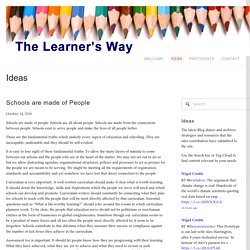
Schools are all about people. Education is an end in itself – TallBlackOneSugar. Unfortunately all the adults who either had a bad time at school or think now they are adults they can rewrite the history of education, they miss this point.
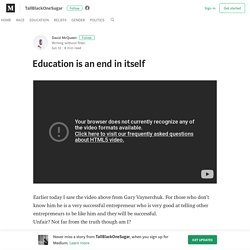
That schooling in education is an end in itself. At it’s heart it is about learning for learning sake. We explore new worlds and we get challenged whether by questions in class, homework or ultimately exams. It is not just about a future career. I loved reading Of Mice and Men with my girls. I felt the same energy when I went into schools as a “motivational speaker” encouraging students to look beyond the test to understand what lessons were teaching them. Why do we group students by manufacture date? – JackieGerstein Ed.D. Ken Robinson once famously said, “Students are educated in batches, according to age, as if the most important thing they have in common is their date of manufacture.”
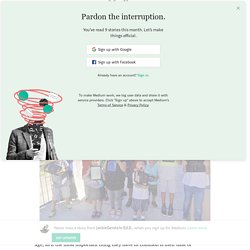
(Ken Robinson, The Element: How Finding Your Passion Changes Everything). I have the privilege of working with 2nd through 6th graders in my gifted education classes and Kindergarten through 6th grade in my summer STEM and robotics camps. With my summer camps, they get to choose their camp by interest not age. In my gifted program, they select from a menu of content areas so it is also interest- rather than age-driven. 8 Attributes of Successful Schools in the Digital Age. Go anywhere in the world, and schools are a focal point of every community.

Without quality schools, students will not learn the skills that they need to master to succeed in the global economy or life in general. Getting the Right Problem in Education – REENVISIONED. Have you heard about the race to create a space pen?
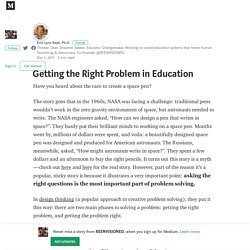
The story goes that in the 1960s, NASA was facing a challenge: traditional pens wouldn’t work in the zero gravity environment of space, but astronauts needed to write. The NASA engineers asked, “How can we design a pen that writes in space?”. They busily put their brilliant minds to working on a space pen. Months went by, millions of dollars were spent, and voila: a beautifully designed space pen was designed and produced for American astronauts. The Russians, meanwhile, asked, “How might astronauts write in space?”. In design thinking (a popular approach to creative problem solving), they put it this way: there are two main phases to solving a problem: getting the right problem, and getting the problem right.
By far the most important phase is getting the right problem. Today, questions about “personalized learning” and “college and career readiness” are driving most of the “innovation” in education. Bringing creativity into classrooms. Shaking off old timetabling structures will be one of the biggest challenges our schools face in becoming more creative organisations.

On one hand, schools are developing incredible curriculum opportunities and creating learning spaces where students can think and work creatively. On the other hand, the timetabling of a student’s day remains very similar to what it was 10, 20, even 30 years ago. Technology isn’t the problem. Yes, you heard it right.

The Federal Education Minister Simon Birmingham and NSW Premier, Gladys Berejikilian have suggested that schools lock up phones until the end of the school day to prevent students’ from being distracted. Naturally the comments generated a lot of debate on radio particularly among frustrated parents and teachers. More than a haircut: how elite schools are struggling with the pressure to excel. Recent reports of tensions in Melbourne’s Trinity Grammar school are indicative of the pressure elite schools are facing to excel in all areas of education.

Trinity’s students, parents and alumni are seething after the sacking of longstanding deputy headmaster Rohan Brown for cutting a student’s hair before school photos. But the anger is aimed less at the haircut than what the sacking represents. A new leadership team has reportedly made wholesale changes to the school since 2014, which have focused on improving ATAR scores while sidelining a culture committed to character-building and social justice. This has caused an exodus of teachers in the last few years, as well as complaints from parents and alumni, which came to a head at the end of last year. The nuances that separate good educators from the great educators. St Posh vs Bog Standard High: how the school system can fight poverty and privilege.
Opinion Updated Media player: "Space" to play, "M" to mute, "left" and "right" to seek.
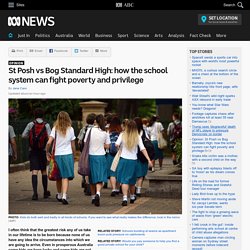
Error loading player: No playable sources found Video: Parents turn to education consultants to find a good private school for their child (Lateline) I often think that the greatest risk any of us take in our lifetime is to be born because none of us have any idea the circumstances into which we are going to arrive. No laptops in the lecture hall – Seth Godin. How about this instead: No lecture hall.

The typical classroom experience used in high school and college is fundamentally broken, but there’s a simple solution. In a recent NY Times op-ed, Susan Dynarski, a professor of education, public policy and economics at the University of Michigan, describes why she has forbidden students from using laptops in her lectures. There’s now plenty of data that shows that in a lecture setting, students with laptops don’t do as well or learn as much as students without one. The reasons make sense, and I applaud her standards and her guts. But she missed the real issue. Change and inertia. I have studied change management in large organisations for over 25 years. Indeed, the very first peer reviewed journal article I published, was entitled 'Managing technological change in nurse education'. It appeared in a British Computer Society journal in 1992. Recently, I was discussing change with teams of academic staff at a large university in the Southern Hemisphere, and as a result of the conversations I developed the model of change which is illustrated here.
It synthesises the work of Clayton Christensen and others, and is a simple linear stage model that attempts to identify sequences of events that can lead to transformation of organisations. What truly drives change in Education? The answer according to CBI includes a “clear focus on attainment for every child”, “better parental and community engagement leads to more vibrant schools”, “better teaching” a curriculum with "rigorous expectations of every child, on both knowledge and the development that we expect schools to deliver” and holding schools accountable for delivering all of these outcomes. Australia’s Productivity Commission added its voice to the conversation in a recent report that became the subject for an article by Ross Gittins of the Sydney Morning Herald.
The Productivity Commission states "A good school system ensures that people have the key foundational skills — numeracy, literacy, analytical skills — and the capacity to learn so that they can easily acquire knowledge throughout their lives. And‘soft’ skills, such as teamwork, collaboration, leadership and creativity are equally essential to adaptability and retention of employment”. By Nigel Coutts Foundation for Young Australians. Inside Australia’s first virtual school. “Culcairn? Um… no… I don’t think I know where that is,” I say apologetically, hurriedly typing the name into the search bar. I’m on the phone to Chris Robertson, the principal of Aurora College, a pioneering virtual school. 8 Things to Look For in Today’s Classroom – George Couros – Medium.
As I think that leaders should be able to describe what they are looking for in schools I have thought of eight things that I really want to see in today’s classroom. I really believe that classrooms need to be learner focused. This is not simply that students are creating but that they are also having opportunities to follow their interests and explore passions.7 The teacher should embody learning as well. Will Richardson recently wrote this in a comment on one of my recent posts on what teachers need to be like in our current day and the focus that needs to be on learning: …we need teachers who are masters at developing kids as learners who are adept at sense making around their own goals.
Modern Schools: Are We Ever Going to Get There? – The Synapse – Medium. How do you ‘create’ values in a school? – notosh – Medium. Can we have an honest conversation about phones in the classroom? - A.J. JULIANI. Finland’s Education System Isn’t Perfect — But We Can Still Learn from It. 10 Education Podcasts for Educational Entrepreneurs Dreamers and Difference Makers. At the beginning of 2017, I decided to expand beyond blogging by also producing and hosting an educational innovation podcast. Thinkering Studio: Supporting Self-Directed Learning. Getting Past the Attention-Span Myth (Thoughts on Creative Focus) What happened when one school banned homework — and asked kids to read and play instead.
The way we teach our children is truly crazy. Bored Out of Their Minds. Discipline, Punishment and Mental Health – Friction Burns – Medium. “It’s a good school, of course, but…” – The Synapse – Medium. Speedchange.at.medium. 4 Non-Negotiables for Schools – George Couros – Medium. What does the post-truth world hold for teachers and educational researchers? 21st century challenges – Learning {Re}imagined – Medium. Transformation Center. Education is a Team Sport – Medium. Investing in the Learning Generation – Bright – Medium. Moving past the days of the old school yard. The One Word That Prevents Real Educational Reform From Happening — Modern Learning. 9 Elephants in the (Class)Room That Should “Unsettle” Us — Modern Learning. What A Flat Classroom Really Looks Like. What If Schools Had No Rules? It Could Change The Future. — Life Tips.
The 13 most innovative schools in the world. Why we need to pay teachers more. 7 Life Literacy Skills Students Should Have Before Leaving School. There’s More To Education Than Scoring The Highest Marks — The Synapse. The World is Flat: Teachers as Innovators. Jason Ohler - Reinventing Education. My Desk-Free, Student-First Classroom — Bright. 16 Modern Realities Schools (and Parents) Need to Accept. Now. — Modern Learning. Rethinking Education from First Principles.
9 Elephants in the (Class)Room That Should “Unsettle” Us - Will Richardson. If not Gonski funding, then what? School Is Not a Metaphor for Life.